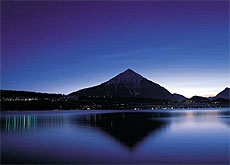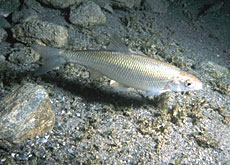Parliament votes to clear munitions from lakes

The Swiss parliament has asked the government to clear munitions and residue explosives dumped at the bottom of Swiss lakes.
However, the government would prefer to allow a research programme now underway to run its course, on the grounds that the toxicity of the munitions has not been proven.
On Tuesday the House of Representatives approved a motion proposed by Ursula Haller, a parliamentarian from the rightwing Swiss People’s Party, by 102 votes to 56 that the munitions, dumped between 1945 and 1963, represent a potential danger to humans and animals.
According to research published last year by the defence ministry, more than 8,000 tons of munitions are sitting in Swiss lakes.
Part of this is old army munitions, the rest is industrial waste from state munitions factories.
“Time bomb”
An estimated 4,600 tons of material are lying in Lake Thun in central Switzerland. Drinking water for some 400,000 people comes directly or indirectly from this lake. Haller called the presence of the munitions a “potential time bomb”.
Deformities in white fish from Lake Thun have raised concerns that the water may be seriously polluted.
Since 2000, the fish have been showing changes in their reproductive organs. The scale and variation of the changes have not been seen anywhere else in the world.
Although it has not been proven what is causing the changes in the fish, suspicion has fallen on the munitions strewn across the bottom of the lake. However, analysis of the water has not revealed any toxic substances.
Research
A five-year research programme was set up in 2003 to establish exactly what was causing the abnormalities. The government wants this research to conclude before it decides what action, if any, to take.
The other lakes which contain shells, fuses and large bombs are Lake Brienz and different parts of Lake Lucerne.
There is no known technique for clearing this material from the lakes, according to the defence minister, Samuel Schmid. What’s more, some of the munitions lie very deep, at more than 200 metres in the case of Lake Thun.
Schmid argued that removing the material from the bottom of the lakes would be more dangerous than leaving it in place, because of the risk of explosion and damage to the ecosystem.
The motion will now be referred to the Senate for further debate.
swissinfo with agencies
A report published by the defence ministry in 2004 stated that more than 8,000 tons of munitions are lying at the bottom of Lake Thun, Lake Brienz and Lake Lucerne.
The material, dumped between 1945 and 1963, includes shells, fuses and bombs belonging to the army, as well as industrial waste from state munitions factories.
A five-year research programme is underway at Lake Thun to establish what is causing changes and abnormalities in its fish.

In compliance with the JTI standards
More: SWI swissinfo.ch certified by the Journalism Trust Initiative

You can find an overview of ongoing debates with our journalists here . Please join us!
If you want to start a conversation about a topic raised in this article or want to report factual errors, email us at english@swissinfo.ch.